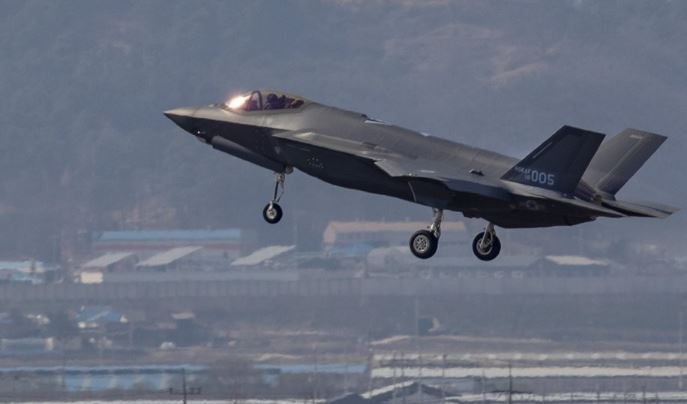S. Korea seeks to increase defense budget 7.4% next year
By YonhapPublished : Aug. 29, 2019 - 10:18
South Korea is seeking a 7.4 percent increase in its defense budget for next year, as it strives to strengthen self-defense capabilities amid growing security uncertainties, the defense ministry said Thursday.
The government has proposed a budget of 50.15 trillion won ($41.29 billion) for next year, up from this year's 46.7 trillion won. If approved, it will be the first time that the country's defense budget surpasses the 50 trillion-won mark.
Of the total, the ministry plans to spend 16.69 trillion won on arms purchases and other projects to boost defense capabilities, up 8.6 percent from this year, and to set aside 33.46 trillion won for running military forces, marking an on-year growth of 6.8 percent.
"In consideration of recent uncertainties in security circumstances of the date, the government has increased investment in the strengthening of defense capabilities to allow our military proactively to respond to security threats from all directions," the ministry said in a release.
North Korea has conducted a series of major weapons tests, involving short-range ballistic missiles. Last month, a Russian warplane intruded into Korean airspace over its easternmost islets of Dokdo twice, prompting the South Korean Air Force to fire hundreds of warning shots.
Looking into details, the ministry is to earmark 6.22 trillion won next year for projects aimed at countering threats from nuclear and other weapons of mass destruction, up 22.6 percent from this year.
The government has proposed a budget of 50.15 trillion won ($41.29 billion) for next year, up from this year's 46.7 trillion won. If approved, it will be the first time that the country's defense budget surpasses the 50 trillion-won mark.
Of the total, the ministry plans to spend 16.69 trillion won on arms purchases and other projects to boost defense capabilities, up 8.6 percent from this year, and to set aside 33.46 trillion won for running military forces, marking an on-year growth of 6.8 percent.
"In consideration of recent uncertainties in security circumstances of the date, the government has increased investment in the strengthening of defense capabilities to allow our military proactively to respond to security threats from all directions," the ministry said in a release.
North Korea has conducted a series of major weapons tests, involving short-range ballistic missiles. Last month, a Russian warplane intruded into Korean airspace over its easternmost islets of Dokdo twice, prompting the South Korean Air Force to fire hundreds of warning shots.
Looking into details, the ministry is to earmark 6.22 trillion won next year for projects aimed at countering threats from nuclear and other weapons of mass destruction, up 22.6 percent from this year.

The introduction of more F-35A stealth fighter jets will require 1.8 trillion won, and the plan to build a 3,000-ton Chang Bo Go-III submarine 659.6 billion won. The budget to secure military reconnaissance satellites will be 234.5 billion won, according to the ministry.
The government will also jack up its budget for its tactical ground-based guided weapons to 63 billion won next year from this year's 600 million won and funnel 155.6 billion won to develop L-SAM, or long-range surface-to-air missiles, up from this year's 55 billion won.
In order to develop key technologies for building a light aircraft carrier, the ministry plans to allocate 27.1 billion won.
With a goal to build capabilities to retake wartime operational control from the United States, the ministry seeks to push for such projects as securing military communication and counter-artillery assets, which require 1.95 trillion won next year, according to the ministry.
"Taken together, 14.7 trillion won would be earmarked to acquire the latest weapons," the ministry noted.
In order to create a slimmer yet more powerful military, the ministry seeks to spend 6.32 trillion won, putting a focus on maximizing the latest technologies for the defense industries and the restructuring of its organization. The government is pushing to slash the number of active-duty troops to 500,000 by 2022 from the current 610,000.
For research and development on cutting-edge defense technologies, such as robotics and drones, the ministry allotted 3.89 trillion won, up 20.7 percent on-year, and the budget to support domestic defense industries surged 50 percent from this year to 70 billion won in 2020.
The ministry also plans to increase the budget to better manage troops and to boost the welfare of service persons by pouring the budget into raising their pay and building new facilities, among others.
The government is set to submit its budget proposal to the National Assembly next week for approval.
The national defense budget has been on a constant rise, from 20.8 trillion won in 2005 to 31.4 trillion won in 2011 and to 40.3 trillion won in 2017.
According to the military expenditure report by the Stockholm International Peace Research Institute, South Korea ranked 10th with its 2018 defense spending of $43.1 billion. The US topped the list with $649 billion, followed by China with $250 billion, Saudi Arabia with $67.6 billion, India with $66.5 billion, France with $63.8 billion and Russia with $61.4 billion. (Yonhap)







![[KH Explains] Hyundai's full hybrid edge to pay off amid slow transition to pure EVs](http://res.heraldm.com/phpwas/restmb_idxmake.php?idx=644&simg=/content/image/2024/04/18/20240418050645_0.jpg&u=20240419100350)







![[From the Scene] Monks, Buddhists hail return of remains of Buddhas](http://res.heraldm.com/phpwas/restmb_idxmake.php?idx=652&simg=/content/image/2024/04/19/20240419050617_0.jpg&u=20240419175937)

![[KH Explains] Hyundai's full hybrid edge to pay off amid slow transition to pure EVs](http://res.heraldm.com/phpwas/restmb_idxmake.php?idx=652&simg=/content/image/2024/04/18/20240418050645_0.jpg&u=20240419100350)

![[Today’s K-pop] Illit drops debut single remix](http://res.heraldm.com/phpwas/restmb_idxmake.php?idx=642&simg=/content/image/2024/04/19/20240419050612_0.jpg&u=)